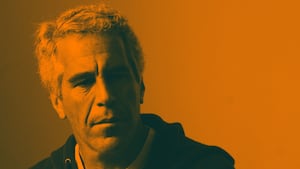Pressure is building on private-equity billionaire Leon Black to resign as chairman of the Museum of Modern Art ahead of a crucial board meeting next week as his ties to deceased sex trafficker Jeffrey Epstein continue to haunt him.
Fevered discussion about Black’s possible departure from MoMA comes a day after Black quit Apollo Global Management, the $455 billion firm he co-founded in 1990. An internal review revealed Black paid the sex offender more than $150 million from 2012 to 2017—three times higher than what was initially reported. The report found no evidence that Black knew of or participated in Epstein’s sexual abuse of girls and young women.
But that same review found that Black and Epstein were unusually close, bound by a series of personal and professional connections stretching back decades. Black loaned Epstein $30 million in early 2017, only $10 million of which was paid back. Black once flew on Epstein’s private plane, the so-called “Lolita Express,” and visited Epstein’s ranch in Stanley, New Mexico and his private Caribbean island, where Epstein’s victims were trafficked and abused. He also spent time with Epstein in Florida and in France, and they socialized in New York, often over breakfast. Black funded Epstein’s favorite researchers at MIT and Harvard, and gave $10 million to Epstein’s secret charity. “Black confided in Epstein on personal matters, and Black introduced Epstein to his family,” the report found, adding: “Black stated that he was repulsed by the details of Epstein’s crimes that were published in late 2018...” By then, those crimes were well and widely known. Epstein’s pyramid abuse scheme had been the stuff of headlines since 2010. The legal battles between Epstein’s associates, his victims, and Epstein himself had dragged on, in public view, for years.
Black denies any involvement in Epstein’s trafficking ring. In October, he told shareholders on an earnings call that palling around with Epstein after his 2008 conviction for soliciting a minor in Florida was a “terrible mistake.”
“Let me be clear,” Black said. “There has never been an allegation by anyone that I engaged in any wrongdoing, because I did not. And any suggestion of blackmail or any other connection to Epstein’s reprehensible conduct is categorically untrue.”
Black previously announced he was stepping down as CEO of Apollo and said he’d hand the reins to co-founder Marc Rowan on or before July 31. But on Monday, Apollo said the 69-year-old Wall Street mogul and art collector quit earlier than scheduled and had also relinquished his role as chairman. In a statement, Black said he planned to spend more time with his family and focus on his health and other passions like art. “And time is precious,” Black said. “My wife, Debra, lost a close family member to the pandemic and faces considerable health challenges. I intend to address my own health issues, and take some personal time to pursue my many interests away from Apollo—including the arts, culture, medical research, and philanthropy.”
Now Black may also lose one of his high-profile positions in the art world: the MoMA chairmanship he’s held since 2018. That year, Black donated $40 million to the museum and had two floors of its film center named after him and his wife.
A rep for Black declined to comment. MoMA did not respond to multiple requests for comment.
Still, the museum looks likely to address Black’s future on the board at its next meeting scheduled for March 30.
None of MoMA’s nearly 80 officers and trustees would speak about Black on the record, though several said they supported him and viewed his relationship to Epstein strictly as business: Black was among a litany of high-powered people to associate with Epstein. One member told The Daily Beast, “It’s obvious to me people used [Epstein], not the least of which as ways to meet other people. And people did do business with him, ergo Leon.”
Another trustee, however, told The Daily Beast that they were troubled by Black’s decades-long friendship and ties with a sexual predator. “There’s people who feel strongly, but there has not been a forum for people to express their thoughts yet,” the person said, referring to the museum’s decision to twice postpone its board meeting since February. Asked if they were bothered by the chairman’s association with Epstein, the trustee added, “Of course it disturbs me. I have a conscience and I have children.”
Last week, the New York Post revealed “a number of MoMA trustees” had contacted Black about resigning once his term ends on July 1. The report indicated the billionaire could rescind the museum’s access to his vast art holdings—including Edvard Munch’s The Scream—should he leave the board altogether. “Remember, if MoMA kicks out Black, they lose a chance at his personal art collection,” one source told the Post.
The Blacks’ collection, said to be valued at $1 billion, also includes Head of a Young Apostle, a chalk drawing by Raphael purchased for $48 million; the $106-million Picasso sculpture Bust of a Woman; and the $27-million Constantin Brâncuși sculpture Bird in Space, which is on display at MoMA.
Calls for Black’s ouster have included a petition signed by a phalanx of prominent artists including Nan Goldin and Xaviera Simmons, who demanded MoMA boot Black over his links to Epstein. “We, as artists and art workers, support the removal of Leon Black from the board of MoMA for reasons that have already been stated by many others. However, this should be considered the bare minimum,” the group said in a statement. One of the signatories, Guerrilla Girls, the anonymous feminist art collective, said it terminated its book contract with Phaidon Press in 2019 because it’s owned by Black. They said MoMA should axe not only Black but fellow trustee Glenn Dubin, a billionaire whose family has longstanding ties to Epstein and whom Virginia Roberts Giuffre, a survivor of Epstein’s sex ring, accused of abuse.
Giuffre says Epstein and his alleged accomplice Ghislaine Maxwell kept her as a “sex slave” and sent her to powerful men including Britain’s Prince Andrew, Dubin, and former New Mexico Gov. Bill Richardson. (All three of the men have denied Giuffre’s accusations.)
“We were outraged by Black’s silence about his relationship to a known pedophile,” Guerrilla Girls said in a prior statement. “So we put up a message outside MoMA demanding the museum kick Black off its Board, along with Epstein pal Glenn Dubin, and tell the world why. It was the least MoMA could do for victims of sexual assault everywhere.”
The art group said: “How could Black, a shrewd businessman and guy around town, not have known his money subsidized Epstein’s elaborate lifestyle, enabling Epstein to continue abusing and trafficking underage girls right up to his suspicious death in 2019? Was Black complicit in Epstein’s crimes?”
“Why does MoMA tolerate people like Black and Dubin on its Board?” Guerrilla Girls added. “If we’re stuck with a system where our tax-exempt, educational institutions have to depend on money from the superrich, they should at least choose donors who make the world a better, not a worse place.”
Black has been under fire in the press for his ties to Epstein since July 2019, when Manhattan federal prosecutors charged the 66-year-old financier with exploiting girls as young as 14 from 2002 to 2005. And the media firestorm didn’t fade after Epstein killed himself in jail one month later.
Their relationship is also being investigated by at least one government official: Denise N. George, the attorney general for the U.S. Virgin Islands, who subpoenaed Black as part of her civil racketeering lawsuit against Epstein's estate and companies. (George has also subpoenaed Dubin for all communications relating to Epstein and Dubin’s three children, along with records relating to a Swedish girl who traveled with Epstein.)
Shortly after Epstein’s New York indictment, Black sent an email to Apollo employees addressing concerns about his relationship with the money manager. “I was completely unaware of, and am deeply troubled by, the conduct that is now the subject of the federal criminal charges brought against him,” Black wrote.
At the same time, reports surfaced that Black had donated $10 million to the financier’s secret foundation, Gratitude America Ltd., in 2015 using a shell company called BV70 LLC. “Black felt comfortable making this donation because he understood that Epstein was a strong proponent of scientific innovation,” Apollo’s internal review said. Black also used BV70 to make $30.5 million in loans to Epstein “in connection with an art transaction involving” the perverted hedge funder, who repaid only $10 million despite Black’s demands for repayment throughout 2018.
Their friendship dissolved, the report says, in October 2018 because of a long-running dispute over Epstein’s fees. About a month later, Epstein became a household name after the Miami Herald published a three-part exposé into his Palm Beach trafficking ring and the lenient 2008 plea deal he negotiated with Miami federal prosecutors.
Apollo’s internal report said Black and Epstein met through an unnamed mutual friend in the mid-1990s and “developed a personal relationship.”
“While Black and Epstein discussed estate planning, philanthropy, and related issues over the years, Black did not engage Epstein to provide him with any services until 2012,” the report claims. “Initially, Black viewed Epstein as someone who was very intelligent and knowledgeable regarding issues relating to estate planning and taxation. Black also was impressed by Epstein’s connections to many prominent figures in business, politics, and science. Epstein spoke knowledgeably about scientific innovation and technology. He introduced Black to well-regarded researchers at Harvard University and the Massachusetts Institute of Technology and encouraged Black to donate to charitable causes that supported scientific development.”
Indeed, Black’s name has surfaced in multiple reports on Epstein’s companies and donations—including internal reviews by Harvard University and the Massachusetts Institute of Technology, as well as Deutsche Bank.
An MIT report said Epstein claimed to have set up anonymous donations for the school’s Media Lab from Black and Microsoft co-founder Bill Gates. “Black has publicly acknowledged donating to charities ‘affiliated’ with Epstein, but has not specifically addressed whether he donated to MIT or whether Epstein asked him to donate to MIT,” the document concluded. “Notably, we did not find any evidence that the money donated by Gates or Black actually was Epstein’s money—that is, there is no evidence that Gates and Black acted to ‘launder’ Epstein’s money.” The backlash over Epstein’s donations to the MIT Media Lab caused director Joi Ito to resign in 2019.
For its part, Harvard noted that Epstein helped two professors obtain millions in donations from Black: Martin Nowak, who helmed the university’s Program in Evolutionary Dynamics, and Harvard Medical School geneticist George Church. “Jeffrey Epstein introduced Mr. Black to the research that was being undertaken by Professors Church and Nowak,” a representative for Black told Harvard counsel for the university’s own report. “Mr. Black met with Professors Nowak and Church to discuss their research in Cambridge, Massachusetts and, in the case of Professor Church, also at Mr. Black’s New York office. The gifts made in support of Professor Church’s and Professor Nowak’s research were made by Mr. Black. None of the funds were provided by Mr. Epstein and no attempt was made to conceal the source of these gifts.”
The Apollo report further illustrated the social and financial ties that bound Epstein and Black. In 1997, Black named Epstein a director of his family foundation, whose only other officers were himself and spouse Debra. While Black claims Epstein left this position in mid-2007—when the FBI was investigating him in Palm Beach for abusing minors—the foundation’s tax forms continued to list Epstein through 2012.
And Black continued to socialize with Epstein and pay him for estate and tax planning, among other services, even after his 2008 conviction in Florida.
“Following Epstein’s prison sentence, Black believed that Epstein had served his time and that it would not be inappropriate to maintain a personal and professional relationship with Epstein,” the report notes. At the time, Black thought Epstein’s crimes were “limited to a single instance of soliciting a 17 year old prostitute that Black believed Epstein had mistakenly understood was older.” The report also says Black “believes in rehabilitation, and in giving people second chances.”
According to the report, “Black viewed Epstein as a friend worthy of his trust.” The billionaire regularly visited Epstein in New York, including at events with other prominent guests, and “confided in Epstein on personal matters.” Black and his wife visited Epstein at his residences in France, Florida, the Caribbean, and New Mexico but never spent the night, the report claims. “At Epstein’s request, Black and his wife provided transportation from Santa Fe to California on Black’s plane to two or more of Epstein’s adult guests in Santa Fe,” a footnote in the report states.
“Black viewed Epstein as a confirmed bachelor with eclectic tastes, who often employed attractive women,” the review says. “However, Black did not believe that any of the women in Epstein’s employ were underage. Black has no recollection of ever seeing Epstein with an underage woman at any time.”
The internal report says that for years, Epstein managed Black’s art collection and counseled him on forming a new art partnership and “obtaining a potential advisory opinion from the New York State Department of Taxation and Finance regarding a contemplated transaction involving Black’s art.” Epstein was also “fairly involved in assisting Black in connection with the sale of certain pieces of artwork” and advised him on “the contested ownership of a Picasso sculpture.”
In 2015, Black purchased Bust of a Woman from the artist’s daughter, Maya Widmaier Picasso, for $106 million. The Qatari royal family and their agents, however, challenged the transaction; they said they’d already reached a deal with Widmaier Picasso to buy the sculpture for about $42 million two years before. Both sides reached a settlement in 2016, with Black the winner of the piece.
Around the same time, Black and Epstein’s relationship started to unravel. Epstein began demanding tens of millions in fees for supposedly coming up with a tax-planning transaction that saved Black $600 million. He emailed Black throughout 2016 and 2017 to pressure him to pay more for the expertise. “Epstein also would invoke his friendship with Black in those emails,” the Apollo report states, “including by referencing personal matters that Black had shared with Epstein in confidence, although there is no evidence that those matters had any relationship to any of Epstein’s criminal activity or to any of Black’s payments to Epstein.”
Black, per the report, “was shocked” when Epstein’s sex crimes made news in late 2018. “Some witnesses noted specifically that they did not believe Black would have allowed Epstein to be introduced to Black’s wife and children if Black had had any suspicion that Epstein had done anything inappropriate or illegal with girls or young women,” the review says.
But at least one guest who attended a swanky pool party at Black’s Hamptons property in 2015 was surprised to see Epstein among the swimsuit-clad revelers.
“Leon had a personal relationship with Jeffrey, and I found it odd,” one witness told the Post. “Why was what Jeffrey did not that bad?”









